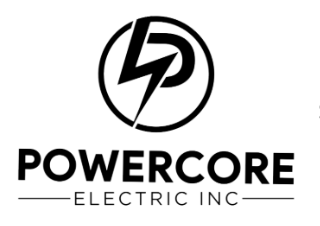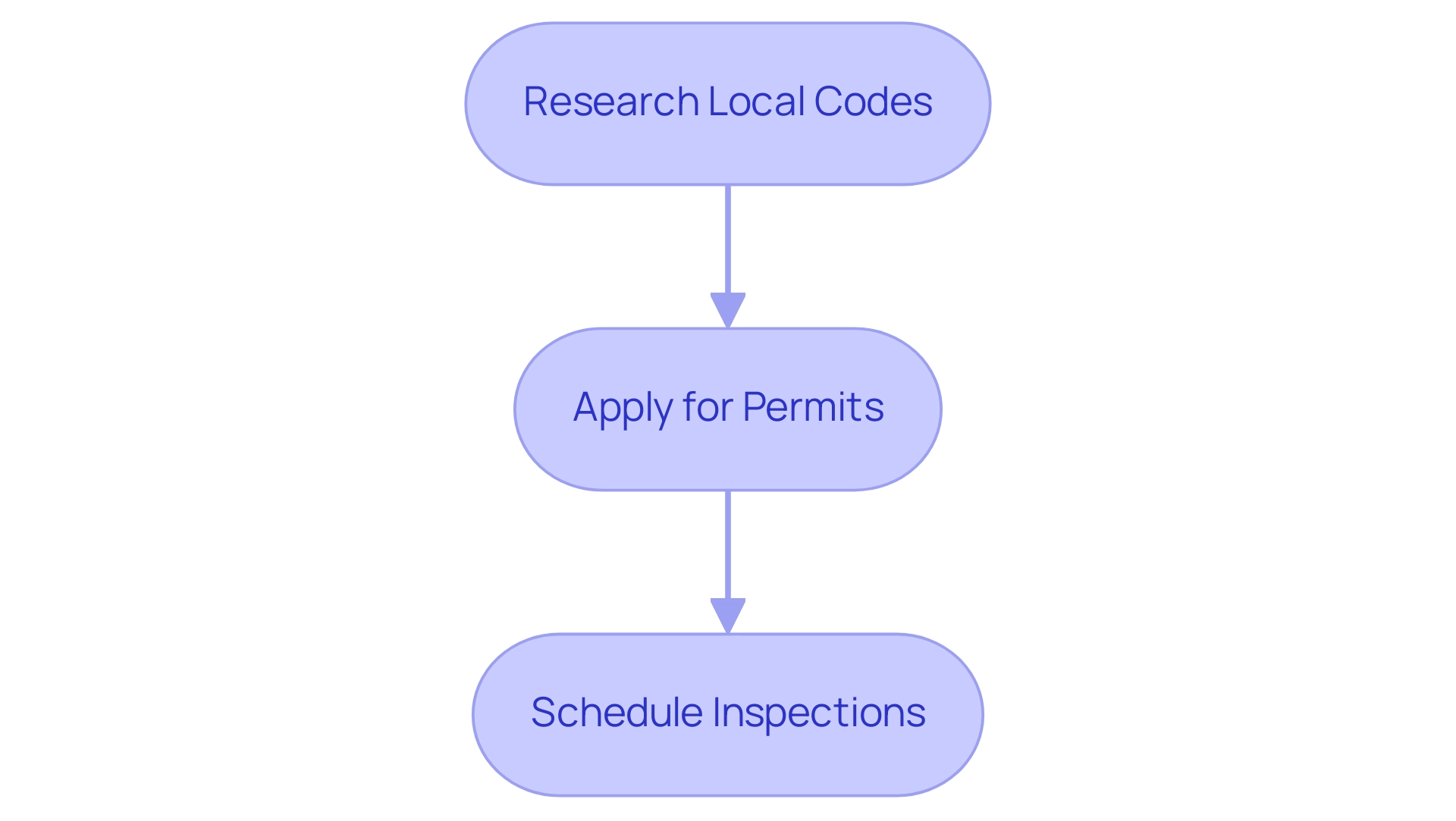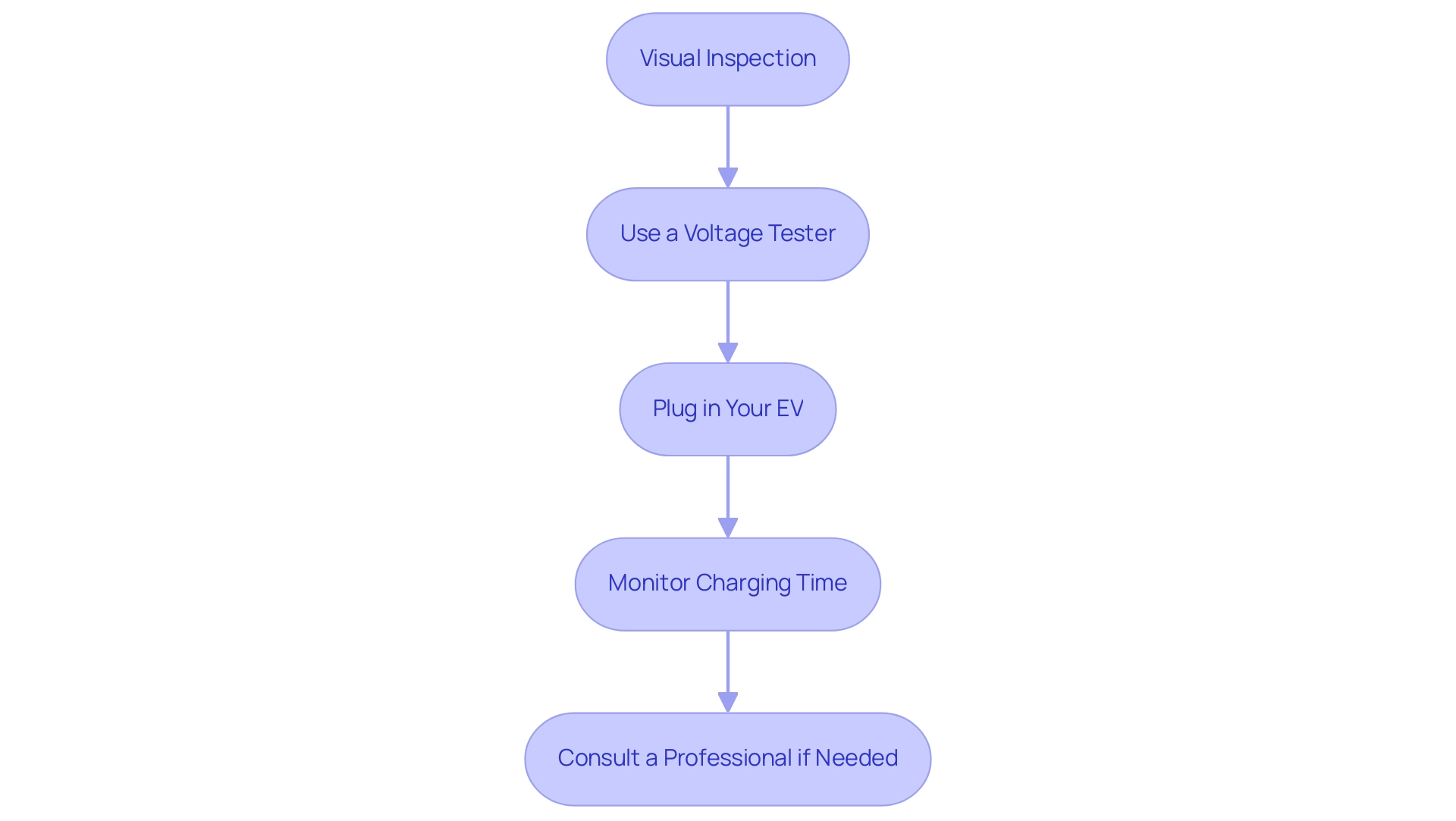Overview
The article provides a comprehensive step-by-step guide on how to install an electric car outlet, emphasizing the importance of assessing the home’s electrical system, selecting an appropriate location, and ensuring compliance with local codes and safety standards. Each step is supported by practical advice, such as consulting with professionals when needed and considering different types of chargers based on individual driving habits, ensuring a safe and effective installation process.
Introduction
Installing an electric car outlet at home is an exciting step toward embracing a more sustainable lifestyle, but it can also feel a bit overwhelming. With the rise of electric vehicles, many homeowners are eager to set up their own charging stations, yet they may not know where to start. This guide walks through the essential steps:
- Assessing electrical systems
- Selecting the right charger
- Understanding local codes
- Ensuring safety during installation
By breaking down the process into manageable parts, homeowners can feel confident and empowered as they take on this home improvement project, making electric vehicle ownership not just feasible, but enjoyable.
Essential Steps for Installing Your Electric Car Outlet
- Assess Your Power System: The first step in setting up your car charger is to take a good look at your home’s electrical system. It’s essential to ensure it can handle the extra load of a vehicle (EV) charger. As Greg Sowder, President of Qmerit, advises, “Assessing your home’s electrical capacity is crucial to ensure a safe and efficient installation.” If you’re unsure, don’t hesitate to consult with a licensed electrician—it’s better to be safe than sorry!
- Select a Location: Next, think about where you want to place your electric car outlet. Ideally, it should be close to where you park your vehicle, making it easy to plug in when you return home. Select a location that’s easily reachable and offers sufficient space for the electric car outlet installation setup.
- Gather Necessary Tools and Materials: Before diving in, gather all the tools you’ll need—think drill, screwdriver, wire cutters, and don’t forget your safety gear! You’ll also need to purchase the right outlet, circuit breaker, and wiring based on the type of charger you’ve selected. It’s like gathering your supplies for a home improvement project; preparation is key!
- Turn Off Power: Safety first! Before you begin any setup tasks, ensure to turn off the power at your home’s main electrical panel. This step is crucial to avoid any accidents while you’re working.
- Install the Outlet: Now for the fun part—installing the outlet! Follow the manufacturer’s instructions closely, ensuring it connects securely to the circuit breaker and that all wiring complies with local codes. This is where a little attention to detail goes a long way. If your electrical system needs enhancements, ensure these are finished before the electric car outlet installation to meet the necessary standards.
- Contact Powercore Electric: If you’d prefer professional assistance, Powercore Electric specializes in the setup of EV charging stations. They perform comprehensive site evaluations, manage any required electrical enhancements, and ensure that the electric car outlet installation complies with all safety and regulatory standards. You can reach them at ryan.serrano@powercoreinc.net or call (916) 699-8778.
- Test the Installation: After you’ve set up the outlet, restore the power and give it a trial with your plug-in car. Make sure everything is functioning smoothly. If you run into any hiccups, don’t hesitate to reach out to a professional electrician or Powercore Electric for help. It’s always a good idea to have an expert in your corner!
As the demand for powered transport continues to rise, with global sales hitting 14 million units in 2023—a 35% increase from the prior year—the significance of home charger setups cannot be overstated. Furthermore, the continuous advancement of high-capacity power supply technology for heavy-duty transports underscores the necessity for strong home energy solutions that can accommodate the rising demand on the electricity grid.
Choosing the Right Type of Electric Vehicle Charger
When it comes to selecting the right electric car outlet installation for your home, it’s important to understand the different types available and their associated costs:
-
Level 1 Charger: This entry-level option utilizes a standard 120-volt outlet, making it straightforward to install. While it’s excellent for overnight power replenishment, it tends to be slower and is more suitable for those who drive less frequently.
Cost-effective, it generally requires minimal investment, typically ranging from $300 to $600 including installation.
-
Level 2 Charger: A popular option for homeowners, this 240-volt charger significantly decreases power-up times, making it ideal for those with daily driving requirements. The costs of electric car outlet installation can vary based on your home’s electrical system capability.
On average, homeowners can anticipate spending between $500 and $2,000 for an electric car outlet installation, which includes setup. For Tesla power stations specifically, installation costs can be at the higher end of this range, especially if electrical upgrades are needed. This option becomes even more appealing when coupled with solar energy solutions, as it can help maximize your energy efficiency and reduce long-term costs.
For example, incorporating solar energy can reduce the electricity expenses linked to powering, potentially saving homeowners hundreds of dollars each year. In fact, the expanding framework for battery-powered transport refueling, demonstrated by a 30% rise in publicly available chargers in Europe in 2021, backs this decision.
-
Smart Chargers: For the tech-savvy homeowner, smart chargers provide exciting features that monitor and control the power process through a smartphone app.
With functionalities like scheduling and energy usage tracking, these advanced chargers cater to those looking to optimize efficiency, potentially lowering electricity costs when used in conjunction with solar power.
-
Portable Chargers: Flexibility is key with portable chargers, which can be used at home or taken on the road. Typically equipped with adapters for various outlet types, they provide a versatile solution for charging system owners and can be a cost-effective alternative for occasional use, generally costing between $200 and $500.
Before making a choice, it’s wise to consider not just your electric car outlet installation’s specific capabilities and daily driving habits but also the potential financial benefits of integrating solar energy into your charging setup. Moreover, recent government initiatives, such as the Australian Government’s AUD 39.3 million funding to build EV chargers along national highways, reflect the growing support for charging infrastructure. Considering these factors, including innovations such as Electric Road Systems (ERS) that enable automobiles to recharge while in motion, you can select a charger that best suits your lifestyle and improves your ownership experience.
Understanding Local Electrical Codes and Permits
Before proceeding with your charger setup, it’s crucial to consult with your local building department to understand the specific electrical codes and permits that apply in your region. This process typically involves several important steps:
-
Researching local codes is important for electric car outlet installation, so start by looking up the regulations surrounding electric vehicle charger setups.
These local codes will specify essential details such as the type of wiring, outlet placement, and necessary safety measures for electric car outlet installation. Understanding these requirements is vital for a successful installation.
-
Applying for Permits: If your local codes necessitate it, you’ll need to apply for the appropriate electrical permits.
This may require submitting detailed plans and paying a processing fee. Be sure to gather all necessary documentation beforehand to streamline the process.
-
Scheduling Inspections: Once your setup is complete, the next step is to schedule an inspection with your local authority.
This inspection serves as a crucial verification process to ensure that your setup meets all safety standards. Remember, having this inspection done not only keeps your setup compliant but also guarantees peace of mind.
It’s important to note that a minimum of 20 percent electrical capacity is recommended to allow for load management software to share load effectively, providing reasonable charge times for all spaces. Furthermore, charging your battery-powered car at home is not only straightforward but also economical, enabling you to save money while contributing to a sustainable future. By navigating these steps carefully, you’re not only ensuring a safe setup for electric car outlet installation but also aligning with local regulations that support the growing shift towards electric vehicles.
Powercore Electric Inc. offers comprehensive electrical setup services, including estimates, troubleshooting, safety inspections, circuit setups, surge protection, and remodeling, ensuring that your home is equipped for the future. For inquiries, you can contact Powercore Electric Inc. at ryan.serrano@powercoreinc.net or call T: (916) 699-8778. As studies suggest, employees with access to workplace charging are six times more likely to drive an EV, highlighting the critical role of proper infrastructure in fostering a more sustainable community.
Furthermore, understanding local regulations, as outlined in case studies on zoning and permitting, can help jurisdictions strategize updates that facilitate EV infrastructure deployment.
Safety Precautions During Installation
To ensure a safe setup process for your electric vehicle charger, it’s crucial to follow these essential precautions:
- Wear Personal Protective Equipment (PPE): Always equip yourself with safety glasses, gloves, and sturdy footwear. These items are essential to protect you from potential electrical hazards during the setup process.
- Use Proper Tools: Check that all your tools are in excellent condition and specifically designed for electrical work. Using damaged or inappropriate tools can significantly increase the risk of accidents.
- Follow Manufacturer Instructions: Always adhere closely to the setup guidelines provided by the charger manufacturer. This step is key to ensuring that the charger is compatible and safely installed.
- Double-Check Connections: Before flipping the power back on, take a moment to double-check that all connections are secure and that there are no exposed wires. This extra step can save you from potential hazards.
- Have a Professional on Standby: If at any point you feel unsure about the setup process, don’t hesitate to call a licensed electrician. With home electrical fires accounting for an estimated 51,000 incidents annually, resulting in hundreds of injuries and significant property damage, having an expert on hand can provide peace of mind. It’s always better to be safe than sorry.
At Powercore Electric, we specialize in a comprehensive setup process for EV charging stations, which includes:
- Site Assessment: We conduct a thorough assessment of your property to determine the best location for the charging station and assess any electrical requirements.
- Electrical Upgrades (if necessary): Depending on your existing electrical infrastructure, we may need to upgrade or modify it to accommodate the charging station.
- Electric Car Outlet Installation: Once the site assessment and electrical upgrades are complete, we carry out the electric car outlet installation for the EV charging station, ensuring it meets all safety and regulatory standards.
- Testing and Commissioning: We rigorously test the charging station to ensure it’s functioning optimally before handing it over to you.
Additionally, since the 1970s, ground fault circuit interrupters (GFCIs) have helped cut the number of home electrocutions in half, underscoring their importance in any setup. Remember, prioritizing safety is not just about following steps—it’s about protecting yourself and your home. Hiring qualified professionals can further ensure that the installation is done safely and correctly.
Testing Your Electric Car Outlet After Installation
Once the electric car outlet installation is complete, it’s crucial to ensure everything is functioning smoothly. Here’s a friendly step-by-step guide to testing your vehicle charging outlet:
- Visual Inspection: Begin with a thorough visual inspection of the outlet and wiring. Look for any signs of damage, loose connections, or burn marks—these could indicate potential issues that need addressing before you attempt to charge your vehicle.
- Use a Voltage Tester: Grab a voltage tester to check if the outlet is indeed receiving power. Insert the tester into the outlet according to the manufacturer’s instructions. This quick check will confirm whether the electricity is flowing correctly.
- Plug in Your EV: Next, connect your electric auto to the outlet. Observe the power-up process closely. Your automobile should detect the charger and start the power process without any error notifications. If it doesn’t, it’s a signal that something may be amiss.
- Monitor Charging Time: Keep an eye on how long it takes for your car to charge. Compare this with the specifications of your charger. If your car takes significantly longer than expected, it might be worth investigating further, as this could indicate an issue with the electric car outlet installation.
- Consult a Professional if Needed: If you encounter any issues during your testing, don’t hesitate to contact a licensed electrician from Powercore Electric Inc. Their expertise can assist in troubleshooting any problems, ensuring that your power supply setup is safe and efficient.
As you prepare your home for an alternative transport option, consider incorporating solar panels and battery backups for a more sustainable energy solution. Solar panels work by converting sunlight into electricity, providing a clean and renewable energy source for your home. When combined with suitable solar batteries, like lithium-ion types, you can retain surplus energy produced during the day for utilization at night or during outages, improving your energy autonomy.
Powercore Electric provides extensive services, including solar panel setup, optimal battery selections for energy storage, and electric car outlet installation for EV power stations. For more information or to schedule a consultation, contact Powercore Electric Inc. at ryan.serrano@powercoreinc.net or call (916) 699-8778. With the growing demand for charging infrastructure, such as Sweden’s initiatives to electrify highways by 2025 and the establishment of 3,000 battery swapping stations by SAIC, being proactive about your charging system setup is essential.
Remember, seeking expert advice is always a smart move! This proactive approach not only ensures your safety but also enhances the longevity and performance of your electric vehicle charging system.
Conclusion
Taking the leap to install an electric car outlet at home is a significant move towards a more sustainable lifestyle. By following the outlined steps—assessing your electrical system, selecting the right charger, understanding local codes, ensuring safety during installation, and testing the setup—homeowners can confidently create a charging station that meets their needs.
Understanding the various types of chargers available, from Level 1 to smart chargers, allows for informed decision-making tailored to driving habits and budget. Moreover, navigating local electrical codes and obtaining necessary permits ensures that installations are compliant and safe, which is essential for peace of mind. Safety precautions during the installation process cannot be overstated, as they protect both the homeowner and the property.
Ultimately, this process not only enhances the convenience of owning an electric vehicle but also contributes to a larger movement towards sustainable energy solutions. As more households embrace electric vehicle technology, the infrastructure supporting it will continue to grow, paving the way for a cleaner, greener future. With the right preparation and support, transitioning to electric vehicle ownership can be an enjoyable and rewarding experience.


